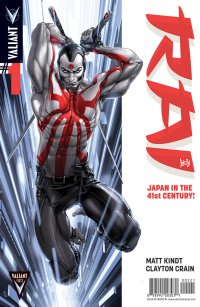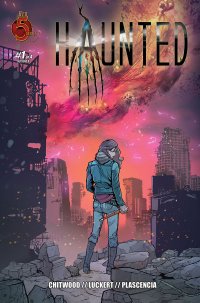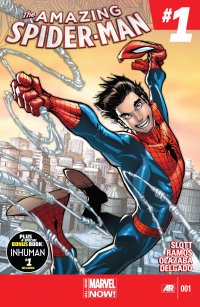Termites in Your Smile – one shot (Split Lip, $0.99)
By Cat Taylor
Termites in Your Smile is an example of the type of comic that you pretty much only find in the digital realm nowadays. I’m not referring to the content of the book, but to the fact that it’s a one-shot story with no previously established characters from a popular series. It would be extremely unlikely for any major publisher to release a book like this in print, and even more of a rarity for a comic book store to take a chance and order copies to stock on their shelves. From a business perspective, nobody could blame them because comics like this don’t typically sell well. However, it is the kind of story on which somebody may take a chance and pay a dollar to read online, if they are intrigued by the promotion for the book.
With Termites in Your Smile, Sam Costello has crafted a story that will be enjoyed by the same people who still like watching old episodes of Twilight Zone or reading old-school horror anthology comics like classic EC series. It’s the story of a typical man-whore who, at the time of this story, is primarily dating two different women while continuing to pursue others. The two women he’s dating are almost polar opposites. Ruth is a career-minded, independent woman who doesn’t seem to want a commitment. The other is Julie, a young, naïve college freshman who is apparently in love with our “hero”, Rafe. Rafe isn’t just the kind of cad who wants to sleep with every woman he can. He seems to have a need to make them fall in love with him, even though his feelings for them don’t appear to exceed the physical. This isn’t outright explained in the story, but it’s something I picked up by the way he interacts with each of the two female leads. He not only tells Julie whatever it takes to get her to sleep with him, but he also tries to verbally manipulate Ruth’s feelings. However, as I explained earlier, it isn’t necessary for him to do so in order to have a continuing physical relationship with Ruth. Of course, as you would expect in a story like this, Rafe receives some serious comeuppance for his assiness by the end of the story. Anyone who has read or watched any old school twisty horror or sci-fi shorts knows he’s going to pay in the end. So, this isn’t a surprise. The question is only one of “how?” Stories like this are more about the ride rather than the end, but a well-constructed ending can make a big difference. Costello does a more than sufficient job at this story. It’s not one that stands above all the others of the genre, but it does stand equally alongside the better fifty percent.
One unusual thing the creators have done with the digital version of this book is to include the writer’s script at the end. It’s a nice touch that will help a less observant reader catch some of the clues that the writer intended to include in the story along the way. Unfortunately, it also reveals some weaknesses in Douglas Draper’s art that I wouldn’t have otherwise noticed. As a standalone comic artist, Draper is as good as any in the independent community. I specify “independent community” because there seems to be an accepted, perhaps even expected, “independent house style” of making the art look like unfinished sketches from a life-drawing class. The technique and craft is clearly there, panels are laid out well, proportions, actions, depth and dimensions are all quite evident. There’s just a lack of finality to the work where lines aren’t tightened up, shading isn’t completed, and sketches aren’t polished. It’s something that is rarely, if ever, lacking in a comic published by mainstream publishers. Sometimes the lack of polish isn’t missed, but with the original script in hand, I can read about traits of characters and their actions that the writer wanted conveyed that I just frankly didn’t discern in the artwork. The lack of these elements in the art didn’t prevent me from enjoying the story, but I believe I would have enjoyed it more if the art had fully conveyed the writer’s ideas.
Rating: 




Out of a Possible 5 Stars
 Rai #1 ($3.99, Valiant)
Rai #1 ($3.99, Valiant)by D.S. Randlett (@dsrandlett)
Cyberpunk was the last great science fiction movement. Until the genre makes its next great leap, the variations of modern SF will continue to play on the themes established by authors like Neal Stephenson and William Gibson in books like Snow Crash and Neuromancer. And it makes sense: the subgenre reflects a host of anxieties that are part and parcel with living in the modern, connected world. In the face of increasing automation and consolidating wealth and corporate power, what is the value of one individual, possibly artificial, self? That’s one question among many that the genre took up, and one of the questions that cyberpunk’s children still wrestle with to varying degrees of success. It was also, conveniently, one of the questions that superhero fiction was constructed to confront from the earliest days of Superman’s battles against megascientists like Lex Luthor. Superhero comics would eventually create its own future in Legion of Superheroes, which posited a world made a better place by the likes of Superman and Batman, but which still had a need for a rather large group of optimistic teenagers to look out for the little guy.
But then, cyberpunk still seems to have some kind of hold on the public imagination, while the Legion has seemingly fallen to the wayside. As to why this is, I think it has more to do with the mismanagement of the Legion on the part of DC more than it has to do with the irrelevancy of the core conceit of the franchise, but as it stands, Matt Kindt and Clayton Crain are here to fill the future superhero gap. And they’re doing it with cyberpunk. Kindt’s script spends a large part of its time devoted to world building rather than plot, but in doing so he lays the effective groundwork that will allow this series to effectively straddle the thematic concerns of cyperpunk and superhero fiction. The world that Kindt evokes is dark, but not oppressive, and he convincingly evokes a sense of hope in a dark future. The only downside to this approach is that the cliffhanger at the end feels sort of tacked on, despite an absolutely genius inciting incident at the start of the issue.
While Kindt’s work on MIND MGMT and various DC titles has catapulted him to the A-list of comics writers, the real star on Rai is artist Clayton Crain. His work here is very painterly, with just the right amount of digital flourish to bring out the futurism of the world even more than the simple depiction of his subjects. His style recalls the digital painting of Adi Granov (who you may know from a little Iron Man run with Warren Ellis), but with a more tactile feel that evokes the urban chaos of Rai’s setting. Crain does nothing to eschew the cyberpunk influences on Kindt’s script or the book’s place in the superhero genre. Rather, he absolutely revels in both sets of influences, blending them into a cohesive and compelling look. For that, Rai is essential reading.
Rai does the first issue thing very well, but looking back on it it’s hard not to ask for more. Kindt’s story has some great ideas and moments, but it makes very little impact. Of course, this may change as the series progresses. The art more than makes up for any shortcomings, which feel like shortcomings simply because one gets the sense that there’s more thought here than the series is letting on at this point, in the writing. Rai is simply yet another good book from Valiant, and those are always welcome.
Rating: 




Out of a Possible 5 Stars
Haunted #1 (Red 5, $3.50)
By Cat Taylor
There sure are a lot of comics, TV shows, and movies about post-apocalyptic survivors battling with hordes of monsters, and Haunted adds another to the list. Whether it’s a worthwhile addition or not depends on many factors, including your own feelings about the genre, how many similar comics you are already reading, and of course, where the story goes after the first issue.
I think it’s safe to say that the current surge in popularity for this genre can be most attributed to The Walking Dead. So, you’ll be happy to know that Haunted avoids the inclusion of zombies, at least for now. Even without the swarms of flesh-munchers running around, you’ll see a lot of familiar territory, most notably a world where everyone lives in anarchy and scrounges for whatever food, weapons, and other comforts remain. Survivors battle not only each other, but supernatural creatures as well. The creatures in Haunted are much more terrifying than the zombies of most any comic, movie, or TV shows with the word “Dead” in the title. Whereas, zombies (by whatever name) depend on surprise and masses to overwhelm humans who usually can literally run circles around them and use them for target practice, the various ghosts of Haunted are terrifying apparitions that swoop in at night and pretty much kill or possess anyone they touch and there’s not much anyone can do about it because they’re ethereal spirits. Kudos to the art skills of Danny Luckert for making the “shrieks” as visually horrifying as the power they possess.
About the only way to not become a victim in the beginning of the first issue of this story is to keep from getting caught outside after dark. However, that changes when the hero of the story meets a scientist and pastor who have combined their knowledge to invent some weapons that can actually combat the shrieks and other haunts. The alliance of these three characters, and a fourth that joins them later, begins a “road trip” story that forms the basis of the series. From the next issue forward, the characters will try to get to New York City to meet another scientist with whom they can close the gate to the spiritual world and end the “haunting” for good. As I mentioned earlier, where future issues take this concept will say a lot about the quality of the series going forward. Writer Scott Chitwood, is treading on a lot of familiar territory so far with only superficial differences. On the other hand, he shows a knack for compelling storytelling that makes the journey feel worthwhile even if you feel like you’ve made the same trip before.
One thing that Chitwood lacks in the first issue is significant character development. Although this is somewhat excusable given the amount of action and the need to get the main characters together and started on their mission, I don’t feel invested in the characters the way I do early on in many other stories. This isn’t for the lack of Chitwood trying. He makes sure to include a scientific vs. theological debate between the scientist and pastor as they discuss the haunts but considering that it took both of them to invent the weapons that are actually effective against the haunts, it seems like they should have already figured out that they are both right.
Haunted has the cinematic feel of a ready for a television or movie adaptation comic, especially when one thinks about how scary a good visual effects team, cinematographer, and director could made encounters with the shrieks. However, an actual version of this comic brought to screen would likely suffer greatly from comparisons to Walking Dead. As of the first issue, it’s a decent start that has the potential to become really exciting or get dragged into all too familiar territory. I’ll be curious to see which direction Chitwood takes it. At least he has an artist who is highly capable of bringing the eerie feeling needed to make whatever is written feel like a real horror comic.
Rating: 




Out of a Possible 5 Stars
 Amazing Spider-Man #1 (Marvel, $5.99)
Amazing Spider-Man #1 (Marvel, $5.99)
By Jeb D.
Not that there was any doubt about Peter Parker’s eventual return, but in the long history of death and rebirth in superhero comics, it’s hard to think of a return to status quo ante as bittersweet as this one: Superior Spider-Man was far and away the most interesting long-term arc that the character has seen in many years, and while I’m glad Marvel chose not to run it into the ground, writer Dan Slott has set his own bar pretty high in terms of moving on with the refreshed, restarted web-spinner.
As Peter Parker resumes the mask, while trying to pick up the unfamiliar pieces of his life that were lived while Dr Octopus was in his body, it shows confidence on Slott’s part that he turns much of this issue into a sort of meta-textual commentary on the differences between the Superior era, and fans’ regular expectations of the character (“Hey,” marvels one observer, ” Spidey’s cracking jokes again!“, and indeed, this issue has as many good gags in it, both verbal and visual, as I can remember in a Spidey book for quite some time). It’s also good to see that there’s not a simple reset button being pushed here: as I’m sure many readers did, Jonah Jameson expected that being turned out of the mayor’s office in disgrace would lead to an easy resumption of his familiar role as editor of the Daily Bugle, but there’s a rude awakening in store for everyone’s favorite cigar chewing curmudgeon. Similarly, the oddly sweet (and, so far as we know, chaste) romance between Ock-Parker and Anna Maria Marconi isn’t going to be swept under the rug; handled badly, it could be messier than the whole Superior-MJ creepiness we all feared, but Slott’s come far enough with this that I’ll give him the benefit of the doubt going forward. If Amazing Spider-Man #1 isn’t necessarily crammed with action or incident, it has just the right tone to make us welcome back our traditional version of ol’ webhead, while piling a new set of problems onto Peter Parker, many of which he is nicely (from the reader’s point of view) unaware of just yet.
I’m not particularly fond of the “soft retcon,” where we are shown, for the first time, events from a character’s past that you’d have reasonably expected to be referenced long before this; Kurt Busiek pulled it off with Untold Tales of Spider-Man, but equaling that would be a tall order. Fortunately, the “secrets” that Slott digs up here are clearly focused on moving Peter’s story forward, rather than just dicking around with his past.
Neither am I a huge fan of artist Humberto Ramos, but his cartoonish exaggeration is probably better suited to the spinning, tumbling, swinging Spider-Man than most superheroes, even if his anatomical approach to everyday humans is idiosyncratic, at best. As a place-setting issue, there’s less action for him to work with than we recently got in the climactic chapters of Superior Spider-Man, but as things gear up for the mega-Spidey crossover that is waiting in the wings, he should be right at home.
The balance of the 80+ page count includes a reprint of Inhuman #1 (an epic which is evidently in need of a commercial kickstart), and a clutch of short stories moving more pieces into place for upcoming Spidey-related books: an Electro reintroduction from Slott and Christos Gage with art from Javier Rodriguez and Alvaro Lopez that reads like a drab copy of Superior Foes of Spider-Man; Slott and Gage fare much better with a story setting up Black Cat’s desire for revenge on the unsuspecting Parker for Ock-Spider-Man having beaten her up and put her in prison, with art from Giuseppe Camunicoli; a cute old-school precis on Spidey’s powers, gadgets, and supporting cast from Joe Caramanga and Chris Elipoulos, with vintage “4-color” from Jim Charalampadis; the launch of Peter David’s new Spider-Man 2099 series with Will Sliney and Antonio Fabela providing the issue’s artistic high point; Chris Yost, David Baldeon and Jordie Tarragona bring us the latest from Scarlet Spider; and Ramon Perez does a respectable homage to early Ditko on art as Slott introduces yet another new/old character into Spidey continuity.
It’s been said that Marvel’s current editorial policy is more flexible than in recent years, with creative teams being given a general destination (i.e., “Move character A from position Y to position Z in time for the next film’s release“), but allowed more freedom to choose their own means of getting there. Though Marvel somewhat treads on Slott’s toes by having already revealed to the press one of his little secret tidbits from this issue, they’ve given him his head with the character over the past few years, and while not everything has clicked equally well, Superior Spider-Man showed that he could craft a strong superhero adventure that wasn’t wholly reliant on his trick bag of jokes, eccentricities, and Stan Lee-era nostalgia. He’s at the top of his game with this reboot, and if your tolerance for Ramos’ art is higher than mine, this might be at least a four-star recommendation.
Rating: 




Out of a Possible 5 Stars